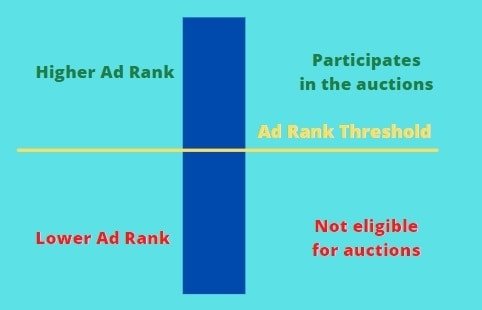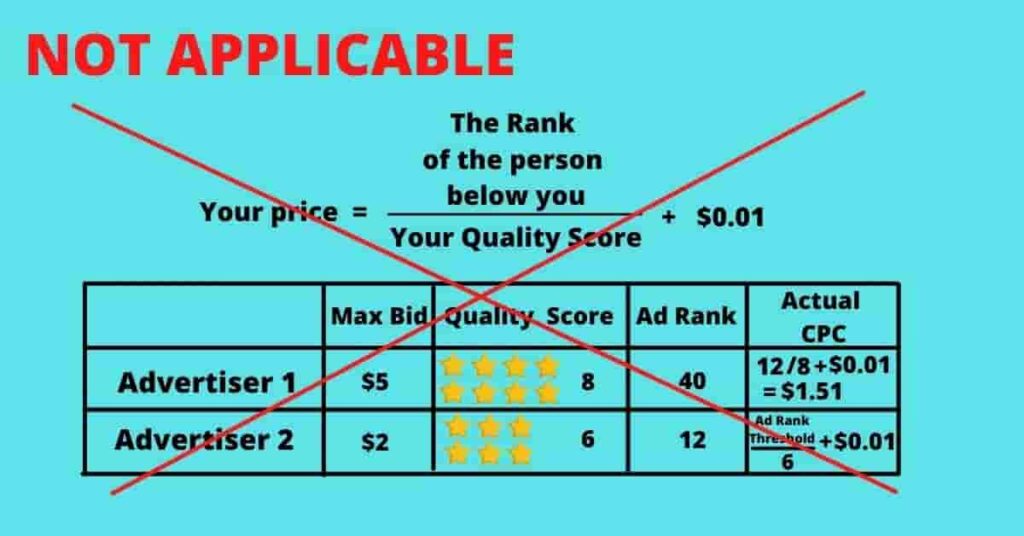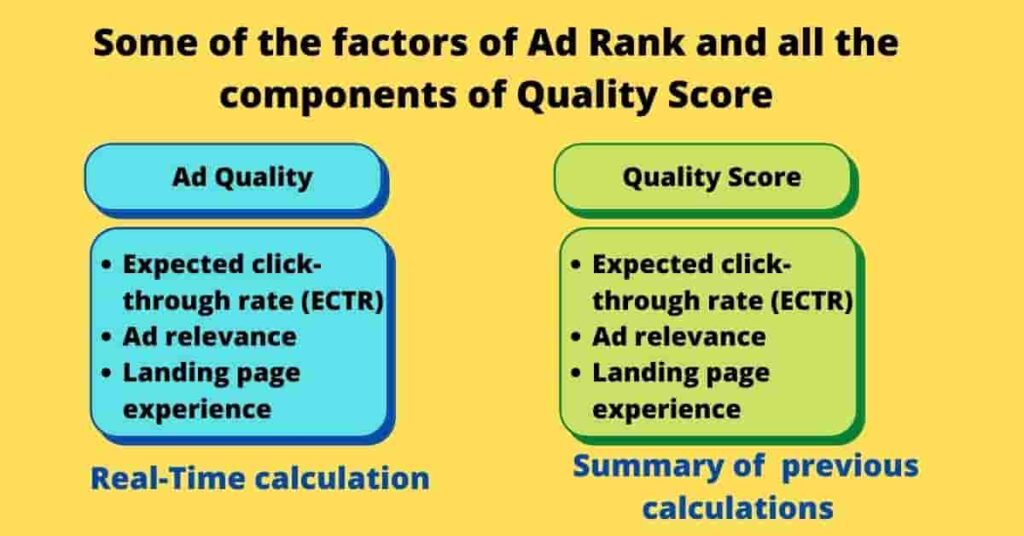Quality Score vs Ad Rank [Differences, Relationships]
![Quality Score vs Ad Rank [Differences, Relationships]](https://wuclick.com/wp-content/uploads/2021/03/Quality-Score-vs-Ad-Rank-Differences-Relationships.jpg)
Two of the most popular metrics in the advertising world are without any doubt Quality Score and Ad Rank.
If you understand them thoroughly and optimize your campaigns to get the highest rating for both, beating your competition becomes much easier.
In this article, I will go through all the differences and relationships of Quality Score and Ad Rank, and also talk about common misconceptions about them even among experienced advertisers.
So, keep reading, as I try to provide the best possible explanations about them in the shortest format.
Differences
Functions
Ad Rank – is a ranking system used by Google ads to compare different ads or determine the position of ads on the SERP (search engine results page).
It is calculated instantly whenever someone searches with your target keywords you are using for your ads. Then, depending on how high their Ad Rank, the keywords may or may not participate in the auctions.

These are the following 6 factors that have the biggest impact on your Ad Rank:
- Bid price – the higher you bid, the higher you rank
- Ad quality – Unlike Quality Score, it is based on real-time results of expected CTR, ad relevance, and landing page experience
- Ad Rank thresholds – It sets the minimum requirement for Ad Ranks to be able to participate in the auctions. Anything below that value disqualifies ads from showing on the SERP even if they have the highest bid
- Competitiveness of an auction – if several ads are competing with one another, the highest-ranking ad’s bid price is determined by the lower ranking ad’s bid price (higher-ranking ad can pay one unit higher price than a lower ranking ad to get a higher position. Here, one unit is 1 cent for the US advertisers.)
- The Context of the person’s search –Ads created for specific locations, devices, times, search queries, etc. can receive higher Ad Rank than ads created for general purposes.
- Expected impact of extensions and other ad formats – additional information for your ads such as Ad extensions can also affect your Ad Rank depending on how Google Algorithm sees them
Quality Score – is a metric that gives general information about your keyword performance.
In order to see the score of every keyword, you need to add Quality Score column to your statistics table. Then, Google ads assigns them a score from 1 to 10, 1 being the worst and 10 is the best.
Components of Quality Score are as follows:
- Expected click-through rate (ECTR) – is a component that takes into account the historical CTR of a given keyword, compares your performances with other ads that use the same keywords, and based on those factors, it estimates your expected CTR
- Ad relevance – measures how relevant your ad text to the intent behind a search query
- Landing page experience – measures the quality of your landing page, ease of navigation, and how relevant the keywords of the landing page to the search query someone types on the SERP
Calculations and indicators
Let me tell you this, the formulas that you see about calculating Quality Scores and Ad Rank are all worthless.
Although it may seem controversial, those guys who talk about the ways of finding the actual CPC or Ad Rank by using their and competitors’ Quality Scores cannot apply them in the real world.
Because they don’t know their own Quality Scores that are used in the real-time auctions let alone knowing their competitors’ Quality Scores.

The 1 to 10 number that you see in your Google ads account is just a general overview of how your account is performing.
Google ads brings this as well on its support page:
We’re continually improving the way that we calculate the quality of your ads, and that calculation will never be captured by a simple 1-10 number. That’s why we call it a guide, not a precise metric.
With all those points that I made, I don’t want you to throw the Quality Score metric out of the window.
You can still get a ton of value out of it to find new opportunities or eliminate underperforming keywords.
For example, if you have a Quality Score of 3 for a given keyword, it indicates that you need to make serious improvements to that ad. Even if that particular campaign is performing well with that score, it signals that there might be room for more improvements.
With Ad Rank though, you don’t have any indicator to show the rank of your ads in the auctions. You also cannot find it through calculations. Because there might be hundreds of different factors involved for every auction that cannot be measured with a simple formula.
The best way to make sure that you get a higher Ad Rank is by improving the main 6 components that we talked about earlier.
Connections with bid prices
Effects of bid prices to Ad Rank and Quality Score
Bid prices have significant effects on your Ad Rank and they both have a direct correlation.
But, it doesn’t have any effect on the quality of your ads. You can pay the highest bid but your Quality Score might still suffer and you may not be eligible to participate in the auctions.
When calculating the Ad Rank, Google ads mostly gives priority to higher quality ads than low quality ads with higher bid prices.
Effects of Ad Rank and Quality Score to bid prices
Now, let’s see the opposite scenario.
If you get a higher Ad Rank, what would be the effect of it on your bid prices?
After you see an increase in your Ad Rank, it means you can bid the same or less to get the same position on the SERP.
Similarly, with a higher Quality Score, you can bid less to achieve the same or higher Ad Rank as before.
So, both of the metrics have an inverse correlation with bid prices.
Ad positions
Ad Rank can directly affect your ad position, whereas Quality Score may or may not affect the ad position. Because as we have seen, there are lots of other factors involved in the Ad Rank that can nullify the added value of a good Quality Score.
Relationships
3 components of Quality Score and Quality of the ads and landing pages metric in Ad Rank look similar but they are not the same.

Think of it as Quality Score shows the delayed performance of some of the elements in the Ad Rank.
For example, if your keyword had 10 thousand impressions yesterday. That means, your Ad Rank was calculated 10 thousand times (keep in mind that the number of auctions can be equal or lower than this number).
So, the Quality Score that you see today in your Google ads account, can show the summary of 10 thousand Expected CTR, Ad Relevance, and Landing page experience that were measured in real-time yesterday.
Which one is more important to focus on?
Your ultimate goal should be to achieve a higher Ad rank with a high Quality Score.
This reduces your ad expenses, increases the quality of your ads, and consequently boosts your ROAS (return on ad spend).
High Ad Rank with less Quality Score or high Quality Score with less Ad Rank both decrease your campaign performance.
Therefore, focus on both of them at the same time by checking your Quality Score numbers and improving other components of Ad Rank that are not covered by Quality Score.
Quality Score vs Ad Rank: Conclusion
These were the main concepts that you need to keep in mind.
If you follow the best practices and create ads that are relevant to your users, you are naturally going to get higher scores for both of those metrics. It is as simple as that.
However, to make use of all the opportunities at your disposal you need to have a good understanding of them, which then increases your odds of success at the auctions.
What components of Ad Rank or Quality Score do you focus on?
Let me know in the comments section below…
For any help to run your Google ads campaigns you can reach me out through the Contact page.

